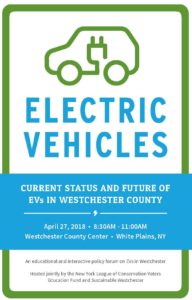On Thursday, June 20th, the New York League of Conservation Voters Education Fund (NYLCVEF) and Energy Vision hosted an educational forum on organic waste and biogas. Two panels of experts discussed the benefits of using food waste and waste from sewage treatment plants to produce biogas, or renewable natural gas.
Biogas is naturally produced as organic waste decomposes. Organic waste refers mostly to food waste, animal waste, and yard scraps. When these materials break down in an environment without oxygen, they release potent greenhouse gases, mostly methane and carbon dioxide. The process of producing biogas is called anaerobic digestion. Currently, most of our food scraps end up in landfills where they release these gases and contribute to climate change. Wastewater treatment plants also produce these gases which are often burned or flared, which is a big waste of a potential resource.
Understanding what biogas is and what the challenges and opportunities are for New York City to tap into this unused resource was the focus of this forum. As both New York State and City expand their food waste recycling programs, the opportunities to produce biogas and use it to heat buildings and fuel vehicles are also increasing.
Matt Tomich, President of Energy Vision, kicked off the forum by introducing the opportunities provided by both food waste and bio-waste. He stated that New York City generates over a million tons of food waste annually, and that wastewater treatment plants produce huge amounts of waste on a daily basis. Advancing technologies are providing ways to better manage our waste and put these valuable resources to good use.
The theme of the first panel was “Organic Waste to Fuel: What is Biogas? How Can it Be Used?” Panelists included Natural Resources Defense Council’s NYC Environmental Director, Eric Goldstein, Vice President of Quantum Biopower, Brian Paganini, Ameresco Senior Project Developer, Jim Bier, and Love’s-Trillium’s, Charles E. Love Jr.
Paganini and Bier both noted that this is a special time for biogas with opportunities to take advantage of the organic resources the city already has. As New York transitions to a carbon neutral economy, this is an ideal time to develop cleaner alternatives to diesel fuel for heavy duty vehicles that are difficult to electrify. Paganini pointed out that there are currently 249 existing biogas production systems in North America, but there is potential for around 8,000 systems. Biogas production would help reduce the amount of organic waste sent to landfills, which Paganini stated makes up around 18% of all solid waste in the city.
Love stressed the value of educating local governments and the public on alternatives to diesel fuel for transportation. He mentioned the cap and trade program in California that incentivizes companies to use renewable fuel for transportation and recommended New York replicate this by using biogas. Goldstein agreed that biogas production has a lot of potential, but the process must be executed carefully so as to be sustainable. He raised a few concerns with biogas production, including ensuring the digestate, the material byproduct of anaerobic digestion, be used as fertilizer instead of being disposed in landfills.
The theme of the second panel was “Challenges and Opportunities for New York.” Panelists included NYC Department of Environmental Protection’s Bureau of Wastewater Treatment Deputy Commissioner Pam Elardo, National Grid Director of Gas Utility of the Future Don Chahbazpour, City of Toronto Director of Solid Waste Management Services Carlyle Khan, and NY Lawmakers for the Public Interest Director of Organizing and Strategic Research Justin Wood.
Khan spoke about the City of Toronto’s waste management system, which includes two food waste processing facilities. He also discussed ways that the city has expanded and incentivized its food waste collection programs.
Elardo discussed the life cycle of food, and how the loop can be closed when organic resources are used to generate energy that can be used in our homes. She mentioned the importance of improving our existing wastewater treatment infrastructure in addition to adding new capacity and technologies. Elardo informed attendees that if the wastewater treatment plants in New York City were upgraded, they could process all of the city’s food waste. NYLCV has been advocating for these upgrades.
Chahbazpour discussed some of National Grid’s efforts to provide clean energy. These include a green gas tariff, a program where customers can voluntarily pay a premium to decarbonize heat. He emphasized the need to reduce transportation emissions by considering alternative fuels, such as biogas. Wood discussed the commercial side of waste collection, as New York City is set to pass legislation to create a commercial waste zone system. This new practice could increase worker safety and reduce pollution. Paying for wastewater treatment upgrades and anaerobic digesters is expensive, but the panelists agree that financing these projects through public-private partnerships is a potential solution.
Adriana Espinoza, NYLCV NYC Program Director asked the panelists how to get New Yorkers to change their behavior and separate their food waste for composting. Wood responded that getting New Yorkers to separate out their organic waste is a challenge because residents aren’t paying for what they throw away, whereas businesses do. The panelists were then asked about the neighborhoods where waste stations are sited and how they think we can best address issues of environmental justice. Elardo said that while living near treatment plants used to be disruptive (due to odor, truck traffic, etc), these facilities are now striving to be friendlier neighbors that provide green jobs.
The forum ended with closing remarks from NYLCV President, Julie Tighe. Tighe connected New York’s landmark climate legislation to the timely discussion of biogas, since decarbonizing the transportation sector is required if we are to achieve carbon neutrality.
You can watch the first and second panels of the forum on our Facebook page.
Thank you to our Gold Sponsors, National Grid and AECOM, our Silver Sponsor, Cummins and Westport, and our Bronze Sponsors, Quantum Biopower and Love’s-Trillium.
Thanks again to the NYU Marron Institute of Urban Management for hosting this event.











